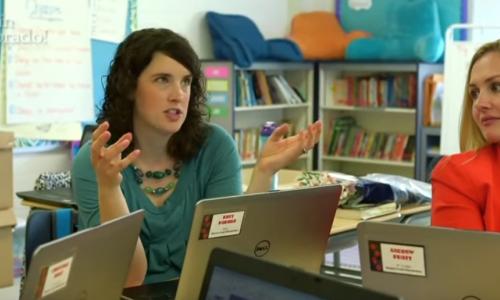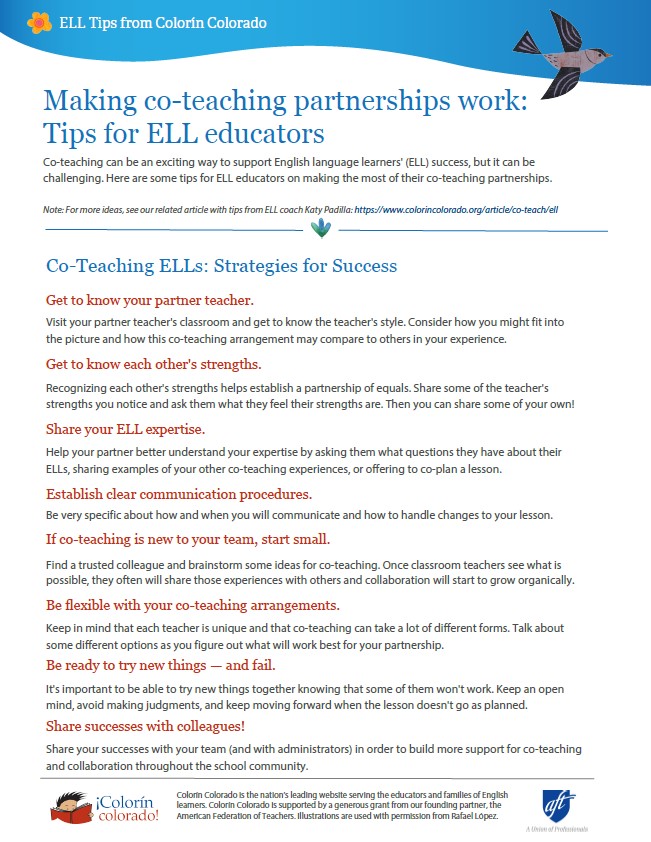Co-teaching can be an exciting way to support English language learners' (ELL) success! It can also present many kinds of challenges. Here are some tips for ELL educators and classroom educators on how to make the most of their co-teaching partnerships.
These recommendations are based on our in-depth interviews with Katy Padilla, an ESOL Coach for Virginia's Fairfax County Public Schools district. In her prior roles as a classroom teacher and ESOL specialist, she worked in a number of collaborative settings and co-teaching partnerships, including at an elementary school that was designed as a professional learning community, Mason Crest Elementary. You can see Katy in action in the videos at the end of the interview!
Co-teaching ELLs: Strategies for Success
1. Get to know your partner teacher.
Ms. Padilla recommends that teachers start by spending some time visiting their co-teacher's classroom and getting to know their teaching style:
- ELL educators can visit their partner teacher's room and watch how the classroom and teacher work. She says, "It's important not to start by jumping into suggestions. It's seeing where that teacher is coming from in order to understand, 'Where is my place in this room? What could be my place in this room?'"
- Classroom teachers can observe the ELL educator co-teaching in another classroom or leading a small group lesson. That can give them some ideas about how the teacher is supporting students and working with other teachers.
2. Get to know each other's strengths.
Ms. Padilla notes that both partners bring different strengths to the partnership. The better acquainted each partner is with the other's strength, the more productive the relationship will be.
- The classroom teacher might be managing lots of different student situations, strengths, and needs and extensive experience in classroom management.
- ELL educators have deep expertise around supporting students' language development, identifying important language for content lessons, and differentiating instruction. They also have a holistic picture of ELLs' educational and social-emotional backgrounds. ELL teachers bring another lens to what classroom teachers are seeing, Ms. Padilla says, which can stimulate their ideas of how to address an issue.
Ms. Padilla also notes that sharing some positive feedback about some admirable skills or qualities is an effective way to build rapport, especially because establishing this respect and trust is one of the greatest challenges for a co-teaching team. "For example," she recalls, "when I was a classroom teacher, I didn't really understand what the resource teachers did. I thought, 'Oh, it's easy they just come in and help.' I never really had to think through the different dynamics, and because I wasn't going into other teachers' classrooms, I didn't realize that the resource teachers had to work with other teachers differently.
"At the same time, it's also easy for resource teachers to come in and say, 'I know what to do for these kids, and I know how to do it here.' But it's not always the case, and the ELL specialist needs to be looking for ways to provide support that can benefit all students in the room."
3. Develop a shared understanding of the ELL educator's expertise and role.
According to Ms. Padilla, many classroom teachers never have a chance to see what ELL educators do every day. That can lead to some difficult situations in which ELL educators end up in the back of the room or being asked to do menial tasks.
The team can develop that shared understanding by:
- Co-planning a lesson together.
- Discussing questions related to ELL instruction or support.
- Talking about other prior co-teaching experiences.
ELL educators can also hold a professional development session on what the ELL teacher (or team) does and how they can work with colleagues.
Ms. Padilla says that creating a situation where the two teachers work together can help jumpstart the collaboration. "Ultimately, it's important to establish that you are equals in the room," she says, "because then the students start to see the team as equals too. It's not one teacher and an assistant. Both teachers are there to support all students, and everyone is on the same team."
4. Establish clear communication procedures.
Establishing open and clear communication is crucial, according to Ms. Padilla, because it's really hard to make co-teaching work without that consistent, effective communication. It's important to be very intentional and specific, she says, figuring out details such as:
- How are we going to communicate?
- When are we going to communicate?
- When is it OK to make a change?
- Are we flexible enough to make a change right before the lesson, or does it need to happen the day before?
For example, she says, with email, "I would send out an email, and not get a reply. Then I wasn't sure if it was not received well, or was it just not received at all. And so it was important to be able to say, 'You know, I really need to have a reply, and it doesn't mean that you have to agree with my idea, but I just need to know that you've gotten it.' That was a huge piece and really helped my teams work together effectively."
Another important piece is follow-through, she says, because it's important to be reliable, which helps establish trust. (This was an area where ELL educators in co-teaching situations have seen a lot of challenges while being pulled so much to cover for other teachers at the last minute during COVID-19.)
5. Be flexible with your co-teaching arrangements.
According to Ms. Padilla, there is a different dynamic in every classroom based on classroom environment, instruction, and personality and her co-teaching situations looked different from room to room.
"In one room," she says, "as the ELL specialist, I didn't lead as much, and I was supporting the students, so that could be me sitting on the carpet with them, making sure that they're following along and that they're getting it, but then I also had the opportunity to speak up and I still had a voice in the room. In another room, I often was in the front; I sometimes took the lead, and the classroom teacher was supporting the students. Other times we broke into small groups, or broke the class in half and we each took a group."
Co-teaching can take on a lot of different forms, she says, but in all of her teams, the teachers worked to establish that they were both there to support all students, which was part of the collaborative culture of this particular school where she worked: "ELLs are everyone's kids, and when we work as a team, I'm supported, she's supported, and we're both supporting the kids."
6. Be ready to try new things – and fail.
Being able to try things and fail is really important, says Ms. Padilla, as is being able to communicate about it afterwards and say, 'I really thought that would work, and it didn't.'" That vulnerability matters, she says, because that starts to open up the trust and both members are ready to take risks and try new things. "We also have to know that we have the safety of, 'I'm not going to judge what you're doing. And we're both here for the kids, and so we're both going to be trying new things. And some will work, and some won't, and that's OK. We'll move forward from that,'" she says. "It's always a work in progress. It's never done. That's kind of the exciting part. It always has the potential to grow and get better over time."
In addition, Ms. Padilla says, be ready to change! Co-teaching changes how teachers work together and sometimes how they work individually as they grow and learn during the year.
7. If co-teaching is new to your team, start small.
For teachers who are just getting started with co-teaching, Ms. Padilla recommends starting small. If your team is trying to figure out how to work together, start with small, short activities and lessons, and check in on what's working.
If you are an ELL educator or classroom teacher who is interested in trying a co-teaching arrangement, she says, "Find one teacher that you already have a relationship with, that you feel comfortable with, and work with that one teacher, and really focus on that is the one collaborative relationship that you're going to build."
She explains, "It can start by the ELL educator saying, 'You know you have these English learners in your room, and I would love to work with them, or see how things are going. Can I come in? I'd like to observe.' Or you can say, 'How do you think your class is going overall? Is there something that you'd like to work on that I can support you with?' That way you can get that feedback from the teacher. And then as you're looking at the data, such as observational data, you can come up with common goal."
For classroom teachers, it can start with a single question about how to address a particular topic or skill, even with a single student. Focusing on a tangible issue to work on together can often help the partnership get going.
8. Share examples of what's working with your colleagues.
Ms. Padilla makes a point to regularly share success stories with groups of colleagues so that people can hear what's working. For example, at the beginning of the school year, her team shares celebrations from the previous year. That could spark some interest from a colleague, she says, who might think, "'Maybe she'd want to try that out in my room. I'd really like for her to come try that because I know I need help in that area.'" And, she notes, that once teachers experience success, they're going to share with other teachers, she says, and a recognition of the benefits of collaboration can spread among the school community organically.
It's also important to share these successes with administrators so that they can provide more official support and resources for collaboration. The more voices that speak up on behalf of the benefits of collaboration, the more compelling the case becomes to make it a structured part of everyone's schedules.
Related Resources
Booklist: Collaboration & Co-Teaching on Behalf of ELLs
 These books offer lots of strategies for collaboration, co-teaching, and planning ELL instruction, assessment, and family outreach. These strategies can be adapted for a wide variety of settings and team structures.
These books offer lots of strategies for collaboration, co-teaching, and planning ELL instruction, assessment, and family outreach. These strategies can be adapted for a wide variety of settings and team structures.
Many of the titles are authored by the foremost experts on this topic, Dr. Andrea Honigsfeld and Dr. Maria Dove.
Co-teaching Best Practices from Drs. Dove and Honigsfeld
These resources on co-teaching were developed for New York State by Dr. Dove and Dr. Honigsfeld.
Podcast: Starting a Co-Teaching Model from Scratch with Dr. Holly Porter
Dr. Holly Porter shares how her district moved entirely from pull-out to fully co-teaching. This conversation on Tan Huynh's Teaching ELs podcast provides practical advice at the district level and can also be applied to schools that want to move away from pull-out to co-teaching.
ENL Co-Teaching Checklist
 For additional ideas, see this ENL Co-Teaching Checklist developed by New York State United Teachers.
For additional ideas, see this ENL Co-Teaching Checklist developed by New York State United Teachers.
Recommended Videos
Video bonus: You can see Katy Padilla in action in these videos, filmed in collaboration with the NEA:
Discussion Questions
- What resonates from this article with you?
- Can you think of a co-teaching situation you have been in where the dynamics helped or hurt the partnership?
- What are some steps you can try to strengthen a co-teaching partnership you have?
- What are your big takeaways from this article?


 These tips are
These tips are 





Add new comment